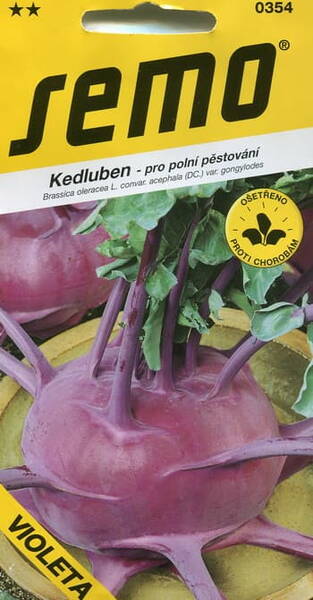Ex Tax: 1.14€
A wonderful combination of taste and nutrition!
Late-ripening variety: the period from germination to harvest is 110-125 days.
It is distinguished by its unique purple-violet coloring of the stems. The plants tolerate short-term frosts and are resistant to bolting.
The stems are large (500-700 g), spherical (6-9 cm), and retain their firmness for a long time. The flesh is tender, juicy, and rich in sugar and vitamins. The taste is excellent.
They are used fresh and for processing. They are grown using both seedlings and non-seedling methods.
Sowing time: April.
Planting seedlings: May.
Harvesting season: June, July.
Planting methods: open ground, seedlings.
Distance between plants: 15 cm.
Distance between rows: 30 cm.
1.0 g = 250-300 seeds.
Biological features.
Kohlrabi is a stem-fruited cabbage. The stem is tasty and juicy until it becomes overripe.
Kohlrabi is a very early-maturing crop—from sowing the seeds to harvesting early varieties takes just two months, while late varieties take four to five months. It's better to use young, tender plants with small stems than to try to grow them to maturity.
Kohlrabi is very tolerant of adverse conditions. However, it thrives in fertilized and moist soils.
Kohlrabi requires a lot of moisture; in dry soils, the stems become smaller and coarser. However, excess moisture leads to blackleg disease.
Prefers a sunny location and light soil. Tolerates light shade. A shallow cultivation layer is sufficient. It is often used as a thickener for late cabbage, tomatoes, and cucumbers, or as a second crop after harvesting radishes, lettuce, and green onions.
Soil preparation. Although kohlrabi is less demanding of soil, like all brassicas, it prefers slightly compacted soil rich in organic matter. In the fall, the soil is limed and manure or compost is added at a rate of 4-5 kg/sq. meter and dug in. In the spring, mineral fertilizers are applied at the following rate per 1 sq. meter: 10 g of ammonium nitrate, 15-20 g of potassium fertilizer, 15-20 g of double superphosphate, or an appropriate amount of complex fertilizer. Part of the potassium fertilizer can be replaced with ash: 100 g (one cup). Do not plant in freshly dug soil. Loose soil should be compacted slightly. Growing from seedlings.
Kohlrabi is grown using seedlings and non-seedling methods.
To obtain an early harvest, use the seedling method. Seeds are sown in late March and mid-May. The seedlings are transplanted into their permanent locations 4-6 weeks later. The most typical and healthy specimens are selected. Avoid allowing the seedlings to overgrow. Seedlings are planted in the garden beds in late April or early May.
Planting pattern: Plants are spaced 20-25 cm apart within a row, with row spacings of 45-55 cm. Early varieties are planted densely: in two- or three-row strips, 15-20 cm apart within a row, 20-25 cm apart between rows, and 50-55 cm between strips. Planting is carried out in cloudy weather or in the evening. Plants are planted slightly deeper than in the nursery. Add a cup of humus to the hole, water, and compact the soil around the seedlings with your fingers. Growing by sowing seeds directly into the ground. Kohlrabi is successfully grown by sowing seeds directly into the ground. Seeds are sown from May to July. In beds, kohlrabi is sown in two or three rows, and the seedlings are thinned out. To obtain central plant heads, leave 15-25 cm between plants and 25-30 cm between rows. For late varieties, the distance is increased.
Care and Fertilizing. Protect seedlings from birds. During the growing season, weed regularly, loosen the soil, and apply 1-2 additional fertilizers. During drought, water generously. One to one and a half weeks after planting, apply the first fertilizer: mix 10 liters of water and 1 liter of mullein. One liter of solution is used per plant. Fertilize also after prolonged rainfall. After each fertilizer application, loosen the soil and hill up the plants.
Harvesting. Timely harvesting is the key to obtaining high-quality produce. Full-ripening stems are harvested when they reach a diameter of 7-10 cm, while early-ripening varieties are harvested even smaller – 5-8 cm. Overripe stems become tasteless and tough. In the fall, the crop is harvested before frost. Disease and pest prevention are the same as for other brassicas. Return to the original location after 3-4 years.












